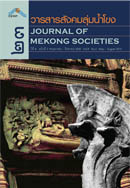Representations of Phanom Rung Sanctuary in the View of Local People
Main Article Content
Abstract
This article discusses the diverse meaning and interpretations of Phanom Rung sanctuary in Buriram province in the views of local people. It is based on qualitative research on anthropology conducted from January to May, 2011 in Ta Pek village, Ta Pek sub district, Chalerm Phrakiat district, and Bul and Nong Bua Rai village, Jarakemak sub district, Prakhonchai sub district. The research found that since 1987 there have been a number of government activities, consisting of those by the Fine Arts Department, Buriram province, and the Tourism Authority of Thailand, leading to the following three major interpretations of the sanctuary: (1) a Hindu shrine which is still sacred, (2) a mortuary monument, and (3) a government tourist site. Most people who accept these meanings have nothing to link their beliefs and practices to the sanctuary. However, some local groups have negotiated those meanings through engaging in local activities and stories at Wat Prasat Phanom Rung (a Buddhist temple) and San Chao Pho Prasatthong (a spirit shrine) which historically were linked to the sanctuary. Although their presentations have a limited impact on non-local people, they increase the various meanings for local people in relation to the sanctuary.


